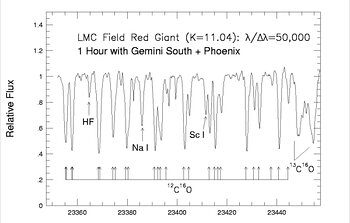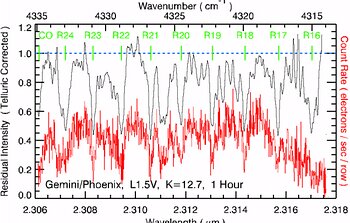Phoenix: Spectra from the commissioning and Demonstration Science run
February 22, 2002

Phoenix, a high resolution infrared spectrograph, originally built for use on the NOAO 4-m telescopes at Kitt Peak and Cerro Tololo, underwent commissioning on Gemini South in December 2001. The first science observing programs were performed in early February 2002. They comprised a Demonstration Science program (described below) and individual science projects from the Gemini queue. Both the commissioning and the science runs were highly successful.
Introduction to Demonstration Science
Our universe initially was virtually entirely hydrogen and helium, as a result of the Big Bang. The heavier elements (which astronomers call "metals") that now make up a small fraction of the universe's mass and our sun's mass (but much of the mass of the earth, and our bodies) were made inside previous generations of stars, which exploded and ejected their material into space. Studies have shown that spiral galaxies, including our Milky Way, have higher abundances of "metals" in their centers than at their edges and that the overall metallicities of galaxies are greater in brighter galaxies than in fainter ones. Our galaxy's metal abundances are primarily the result of two processes: evolution of its own stars; and its consumption of smaller and fainter galaxies and their stars, by virtue of its greater size and gravity. The science described below concerns the abundances in the Large Magellanic Cloud, a close neighbor galaxy to our Milky Way, which is already in the process of being incorporated into the Milky Way.
Large telescopes make it possible to make detailed studies of the chemical abundances in individual stars in external galaxies. Perhaps Gemini's most important contribution to this field will be its ability to make infrared measurements of the chemical abundances of certain elements which cannot be easily measured at optical wavelengths. This advance promises to help astronomers paint a complete picture of galactic chemical evolution from the Big Bang to the present.
Demonstration Science
The aims of Demonstration Science are to demonstrate the capabilities of Phoenix on Gemini South and verify the system performance by executing a specific scientific program. The program was selected from 12 responses to a solicitation in June 2001; the data will be made publicly available after ~2 months following verification and quality assessment by the team.
The main goal of this program is to determine the Oxygen to Iron abundance ratio (O/Fe) in the Large Magellanic Cloud, a key parameter for understanding the chemical history of the LMC in comparison to the Milky Way. The few existing observations suggest that O/Fe is lower in LMC stars than in stars with comparable Fe abundance in our own Galaxy. As the abundance of Oxygen and Iron are sensitive to the chemical yields from two different types of supernovae (SNII and SNIa, respectively), which arise from very different types of stellar systems with different evolutionary timescales, the O/Fe ratio would be a measure of different types and rates of star formation in separate galactic systems. Field K- and M-giants in the LMC were observed in two wavelength regions containing samples of OH, CO, and CN lines, as well as atomic lines from Fe, Na, Si, Sc, Ti, and Ni. The molecular lines allow for C, N, and O abundances to be derived, and thus, any mixing-induced abundance changes in C, N, or O can be determined and accounted for, resulting in accurate oxygen to iron abundances being measured over a range in metallicity in the LMC.
Phoenix on Gemini has the sensitivity to observe many individual late-type stars in globular clusters and nearby galaxies. The excellent image quality of Gemini not only directs most of the light down the Phoenix slit but allows the selection of objects in crowded fields. Objects as faint as K=13 were observed in the Demonstration Science Program.
Early Science
Owing to their faintness and red color, there are few very high resolution spectra of cool dwarf stars and brown dwarfs. The sensitivity of Phoenix on Gemini allows high resolution infrared spectroscopy to be performed on a large sample of these objects and to become an important tool in understanding them. For example, from 2.3 micron spectroscopy, as in the illustration below, carbon and oxygen abundances can be measured using the CO and H2O lines. The widths of the spectral lines also allow measurement of v sin i, which will permit insight into the formation of these objects. Comparison of observed and synthetic spectra will give insight into the atmospheric opacity sources and atmospheric structures of these objects.

